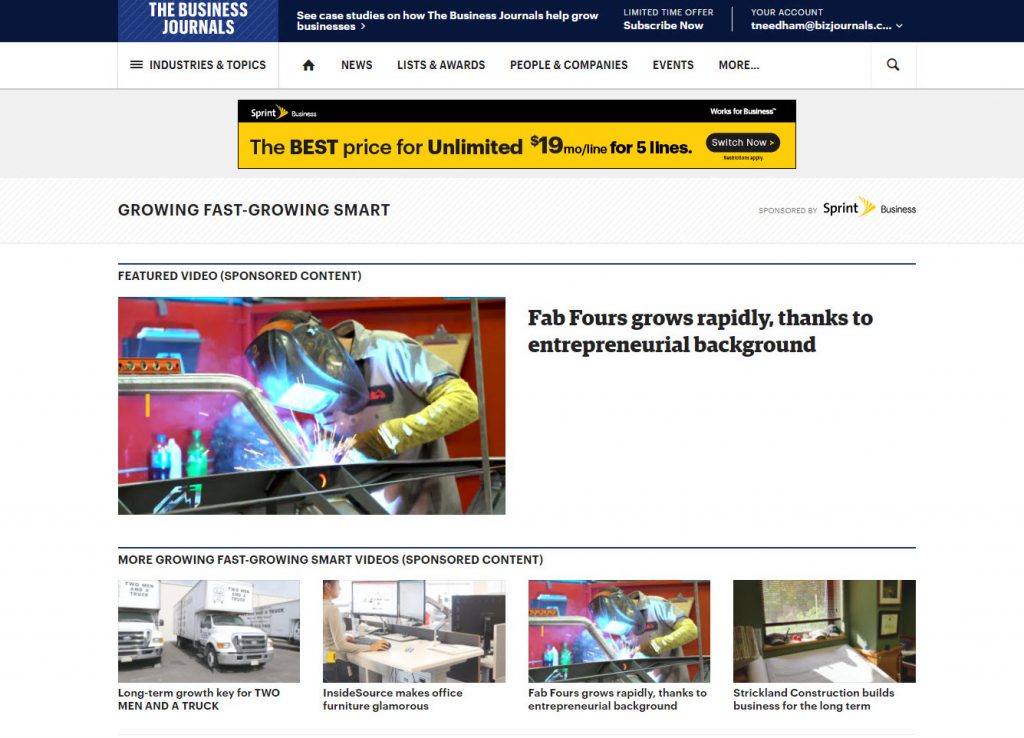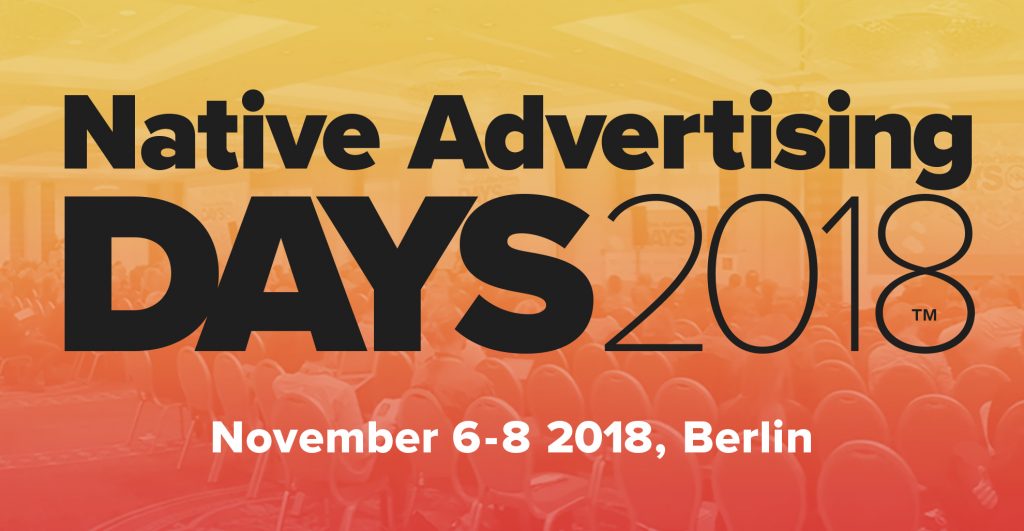This article is part of a series of interviews that NAI has conducted with the directors of publisher’s Native Ad Studios around the world.
Please reach out if you want to add your Native Ad Studio to the series.
The Business Journals report on local and national issues in their 40 business newspapers across the US. At their content studio, hyper-localized native advertising is at the centre.

“What’s unique is we play to our strengths with our national clients by emphasizing our strong local branding and audience. When we help a client reach their footprint, we’re not just geo-targeting ads and content but developing hyper-local programs that could include local events and customized local digital and print content unique to each market within the client’s footprint,” says Tom Needham, Executive Director of Branded Content at The Business Journals,
In this interview, Tom Needham explains how native advertising comes to life at The Business Journals Content Studio, how they measure the success of the campaigns and what they've learned those last few years since the studio started in 2016.
We’re seeing advertisers take advantage of our localized network with localized thought leadership.
A growing business
Why did The Business Journals Content Studio come to life in 2016?
We have TBJ brands in 43 markets around the U.S. and some began dabbling in native advertising as early as 2014. The execution was a collaboration between our local brands and several departments at our corporate headquarters in Charlotte.
RELATED: How Brands and Publishers Can Create a Sustainable Native Ecosystem
The channel had grown to the point where corporate oversight was needed operationally and for oversight of FTC compliance. It was also time for a unified strategy to be established across the network. The channel’s revenue increased by 246% during the studio’s first full year, and 2018 is already positioned to show more growth – proving the decision to be wise.
Commercial real estate thought leadership has also consistently been a leading category for us.
What is trending in native advertising right now at The Business Journals?
Right now, we’re seeing a lot of advertisers positioning themselves as experts around what the new 2018 tax laws will mean to our audience and local business owners.
With our local brands, that message differs state-by-state so we’re seeing advertisers take advantage of our localized network with localized thought leadership. Commercial real estate thought leadership has also consistently been a leading category for us.
Which native advertising solutions do you provide?
We offer native branded content articles and videos on our network of business websites as well as native print opportunities.
RELATED: How Niche Publication Works With Multiple Sponsors and Native Ads About Science
We also offer infographic opportunities and are in the process now of rolling out a high-impact custom content experience that is an immersive one-page experience with multiple content modules.
Webinars have also been hot lately. Putting on custom local events that include digital, video and print is a unique offering that also draws a lot of client dollars.
If we allow our clients to produce content that doesn’t work for them, we’ve failed them as a studio.
Creating local native advertising
What are the benefits when doing native advertising locally?
For our national clients, one of the top benefits is the ability to customize the content. A national client is likely to have regional offices and an article can be localized to position the regional executive as the subject matter expert.
RELATED: How a Philippine Magazine Publisher Creates In-House Native Advertising
We can replicate this in either print or digital, and the result is a national advertiser gets a hyper-localized message delivered through a local, respected business news brand. Our national competitors can’t replicate that ability to localize. On the local front, outside of the local dailies, there aren’t many other places a business owner can reach that audience with the tie to a trusted business source.
And what are the challenges?
Local native advertising presents the same challenges that any native advertising does …. Is the content relevant to the audience? Is it interesting? Does it help the advertiser reach its goal? The learning curve is generally a little steeper with local clients than national brands and agencies, but the challenges don’t really differ.
If we allow our clients to produce content that doesn’t work for them, we’ve failed them as a studio.
How do you overcome these challenges?
You have to hire and build a team that is passionate about branded content, passionate about your brand and understands this is a relationship business. If we allow our clients to produce content that doesn’t work for them, we’ve failed them as a studio.
RELATED: The Washington Post's Brand Studio: Story First, Last and Always
We spend a lot of time in the prep phase of understanding our clients’ desires and goals. At the same time, we understand our own audience and we work to find the intersection of the two. The best course of action is to roll up the sleeves and understand your clients.
How do you decide on a format for your native advertising?
We have a talented sales development team. We’ll partner with them as well as our sales team to brainstorm the best solutions for our clients. Sometimes, our clients have a good idea of what they want but other times they lean on our creative juices.
It’s always the most fun and challenging when they are seeking creative direction. In terms of execution, we huddle up in a meeting room and let the ideas fly and adjust to client feedback.
We spend a lot of upfront time to understand the needs and goals and we keep the client updated usually with weekly calls.
Involvement of brand and editorial team
How much and in what ways are the brands involved in the production of native advertising?
They are always involved. Some clients create and submit their own content. We’ll then offer feedback, fine-tune and edit. Other clients will rely on us to create the content.
In those scenarios, we spend a lot of upfront time to understand the needs and goals and we keep the client updated usually with weekly calls. All native advertising at TBJ has joint approval: the client and the studio.
How do you convince the brands to tell real stories and not overbrand?
The majority of our clients understand that overbranding doesn’t serve their best interests. Occasionally, we’ll run into a client who views it differently.
RELATED: Brands Need to Understand That Native Advertising Is Not About Instant Results
The best way we’ve found to convince clients to tell real stories is by showing examples of how some of our more successful clients told a story that informs and entertains while still leaving the marketing impression the client desires. Then we back that up with data to show how much more effective that approach proves to be.
Is the editorial team involved in the production?
No. We have a thick line at The Business Journals.
We take one of the more conservative approaches in the industry with very clear, prominent and transparent labelling.
Labelling and measuring
How do you label your native advertising?
We label all native as “sponsored content” – the preferred FTC labelling. We take one of the more conservative approaches in the industry with very clear, prominent and transparent labelling.

Our data has shown that transparent labelling has very little, if any impact on reader activity, as well. Good content, sponsored or not, resonates.
Some publishers are much less transparent, using mouseover technology for their disclosures. I’m sure their legal teams have blessed the approach, but I don’t think it’s in the spirit of the FTC guidelines.
Our data has shown that transparent labelling has very little, if any impact on reader activity, as well. Good content, sponsored or not, resonates. In fact, in a recent TBJ reader survey, 74% of our readers said they would like to see more of it. It’s our responsibility to make sure we keep the bar high.
How do you measure the success of the native advertisements?
For the majority of the content, it’s going to be engagement. That will change depending on the format, but generally, you’re looking at plays, hours watched and completion rate for video and for articles you’re looking at overall page views, time on page, scroll depth. Those are the basics of our reporting.
But the success is often not directly seen in the metrics. We had a client tell us that they won new business tied directly to one of their native articles on our site. You won’t find that in a report. When a client shares with our sales team that their colleagues and clients mention they read their content, that’s a very valuable indicator of awareness success.
We use an impression model with tiers of headline impression packages on our site. I think that’s purer than a cost per view model.
Selling and pricing
How do you determine the price of native advertising?
We use an impression model with tiers of headline impression packages on our site. I think that’s purer than a cost per view model. The CPV model may be easy to track and measure, but honestly, that can be gamed. But if you reach the right amount of audience with a well-crafted piece of branded content, success for your clients will follow.
Is your sales team trained to sell native advertising? How?
Yes, they are. We have created training materials and webinars. We also created an internal native certification program. We timed its release with a sales contest involving native. To qualify for the contest, the sales reps needed to be certified. That led to a very high percentage, nearly 90 percent, becoming certified. That was a win-win for the reps, the studio and ultimately, the company.
RELATED: The Perfect Task Force for Native Advertising Consists of the Sales Team and the Editorial Team
The important learnings
I’d say learn from industry best practices but build a plan that plays to your organization’s unique strengths.
What have been your most important learnings so far in relation to native advertising?
Relationships are critical. We are like an agency and if our clients don’t win, we don’t win. Building the relationship with our clients, understanding their needs and goals and collaborating with them is essential.
Some of our larger clients will call us to kick ideas around for some of their internal content projects that we’re not even involved in. That’s a level of trust that comes with repeated successful campaigns and relationship.
Which learnings would you pass on to other publishers who want to set up a native ad studio?
Make a plan that works for your company. All companies are different with different systems, processes and cultures. After about a month on the job, I made a list of the 33 things that needed to be done to create a successful content studio, from reporting to pricing to operations to resources to sales education.
It was our 2-page roadmap to success. I’m satisfied with 27 of them. Still, have some work to do. So, I’d say learn from industry best practices but build a plan that plays to your organization’s unique strengths.
Have you heard about the Native Advertising DAYS? It’s the best conference on native advertising in the World. Read more about it right here.
 By
By 





